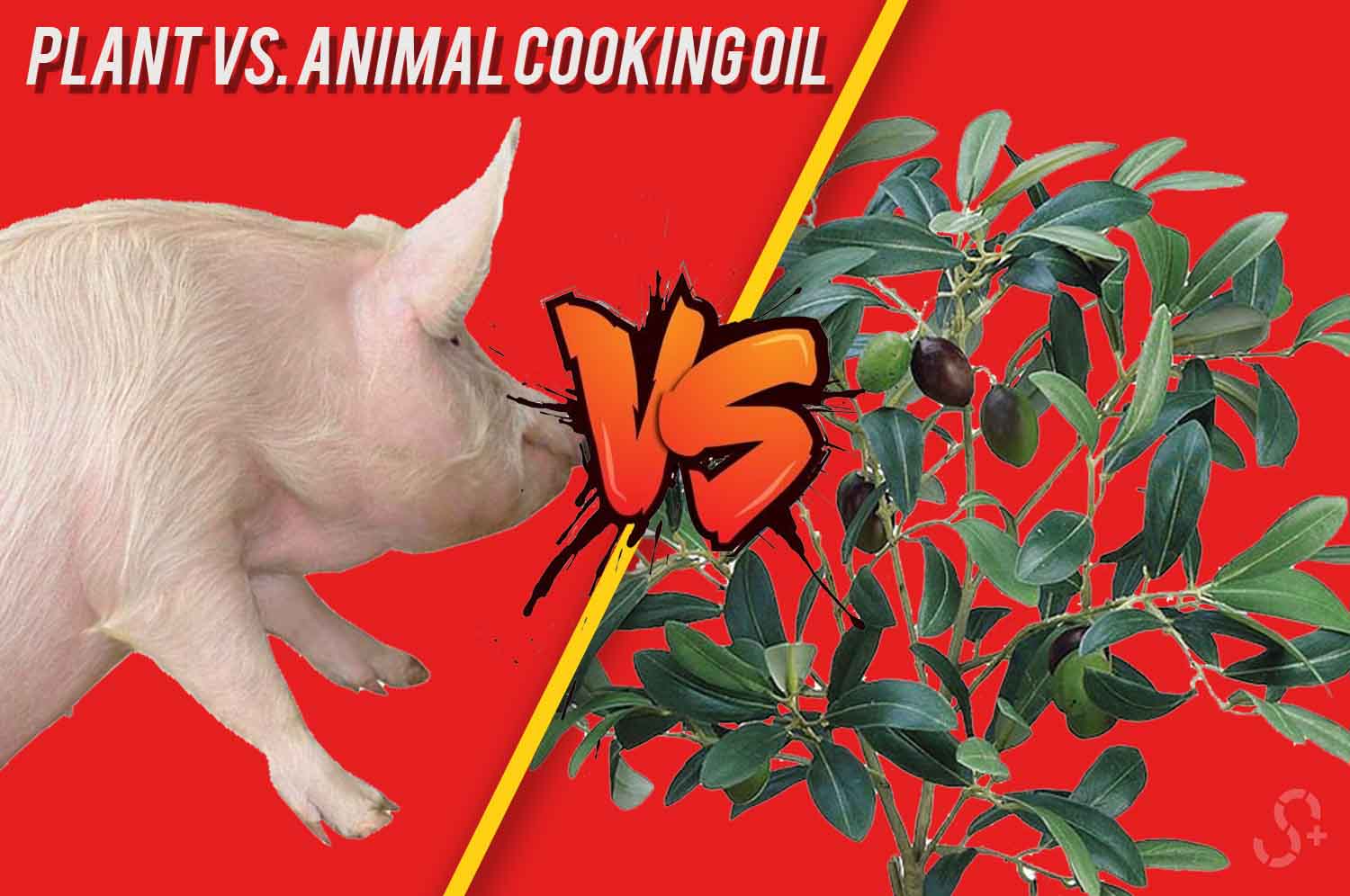The issue surrounding plant oil and animal fat being used for cooking is notably contentious – on the one hand, you have a community who believe that using animal fats to cook is cruel, while on the other, you have people who believe that using plant oil for cooking just doesn’t bring out the complex, intricate flavors of food as well as animal fat can.
What Are Plant Oils?
Plant oils, or more commonly known as vegetable oils, are edible oils that are extracted from pressing the seeds of the plant itself.
Some of the more popular examples of oils derived from seeds are rapeseed (canola) oil, soybean, corn, sunflower, and peanut.
More often than not, these seed oils have to be extracted in unnatural ways involving chemicals.
The oils that are derived from pressing the plant (a natural process) are oils like coconut oil and olive oil.
What are Animal Fats?
Animal fats, like its name suggests, are derived from animals. There are 3 popular types of animal fats used in cooking: ghee, tallow, and lard.
Ghee is basically clarified butter, which has had its milk solids toasted and taken away, leaving just the high-smoke point oil and rich, nutty-flavored butter.
It has been used throughout the Indian subcontinent for over 5000 years and is still a mainstay in Punjabi cuisine today.
Tallow is a fat that is usually derived from cattle – and for that reason, it is normally called beef tallow.
It is made by rendering suet – which is the fat layer surrounding the cow’s organs, in particular the loins and kidneys.
Lard is tallow that is taken from pork. The same process applies, just derived from a different animal.
It is a highly popular fat used in cooking applications worldwide, with a signature taste and texture that many people love.
Health considerations of Animal Fats vs. Plant oils
Animal fat has been used as a traditional cooking fat for centuries.
However, in recent years, animal fat has achieved a terrible reputation, being blamed for many health problems such as heart disease, high cholesterol, cancer, to name a few.
It is often said that if you want to live past 60, never cook your food with lard, or risk blocked arteries and heart complications.
However, scientific studies suggest that animal fats do not lead to increased risks of a heart attack.
In fact, even though people who cooked with vegetable oils had lower cholesterol levels, they were actually at a higher risk of a heart attack.
Furthermore, animal fats have been found to have numerous health benefits, such as helping with fat loss (because it is rich in CLA, a fatty acid that helps to burn fat in humans), and it supports long-term skin health via the saturated fats it contains. Saturated fatty acids are considered to be the building blocks of skin cells, and since what you consume is reflected in your skin, consuming these fats will give you visible benefits.
On the other hand, plant oils have only existed since the early 1900s – and since then, scientists have been thinking up endless ways to process all kinds of plant oils, often in unnatural ways that involve synthetics and chemicals.
For example, take the ever-so-popular canola oil sold in every supermarket you can think of.
They come from canola seeds – which do not actually exist. These “canola” seeds are actually hybrid versions of the rapeseed, which has likely gone through heavy GMO and pesticide treatment.
Once these seeds are harvested, they are heated at unnaturally high temperatures to avoid oxidation (so that they keep longer).
The seeds are then processed with a petroleum solvent to extract the final product – the canola oil, which is then heated some more and mixed with acid to remove any solids, resulting in a clarified product that is advertised with health benefits galore.
Ethical considerations of Animal Fats
To get animal fat, you must first slay an animal. This fact alone is polarizing for most people, and especially for those who are vegetarian or animal rights-leaning, the concept of using animal fat for cooking may be repulsive.
But for animals that have already been slaughtered for consumption, you are able to procure the fat in order to use it for cooking, utilizing every part of the animal.
If you’re looking for raw animal fat, you’ll have to purchase it from a farmer typically, or if you’re lucky, at a good grocery store. For every cut of meat that a butcher prepares, the fat is either left on or set aside – this means you can purchase meat with the fat on, or just the fat separately.
Before you can cook with fat, you must first render it – this means heating the fat until it melts and skimming off any impurities you see that rise to the top. Then your clarified final product, the animal fat, can be used for your cooking.
Plant oils can be grown and harvested in cycles, and often do not produce as many ecological effects as animal farming does.
Smoke points for Animal fats and plant oils
Knowing the smoke point of the oil, you use in cooking is important, as oil eventually breaks down into free fatty acids when heated in a pan for a prolonged period, which may result in bad-tasting food, or even worse – starting a fire in the pan.
Below is a list of the smoke point temperatures of some common Animal fats and Plant oils used in cooking.
| Animal Fat / Plant Oil | Smoke Point |
| Extra Virgin Olive Oil (P) | 325-410ºF (163-210ºC) |
| Sesame Oil (P) | 350-410ºF (175-210ºC) |
| Canola Oil (P) | 400-450ºC (204-230ºC) |
| Tallow (A) | 374ºF (190ºC) |
| Lard (A) | 370ºF (188ºC) |
| Ghee (A) | 482ºF (250ºC) |
For a full list of all animal and plant oil smoke points, click here.
Final thoughts
Sometimes, the world seems overrun with all kinds of scientific studies that always seem to prove or disprove one another when it comes to health benefits.
The bottom line is, however, that some vegetable oils such as canola oil are manufactured in pretty unnatural ways that aren’t actually all that beneficial as they claim to be.
Animal fats have been used in cooking for thousands of years, and it is only recently that they have been led to the noose for purported links to numerous health conditions.
If you’re planning to live a little healthier, it’s always a good practice to check where all of your ingredients come from, even if it is a bit more time-consuming than you’d like. Your body will thank you for it in the end.








